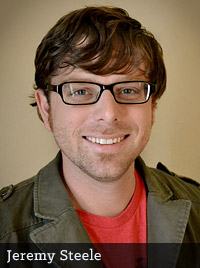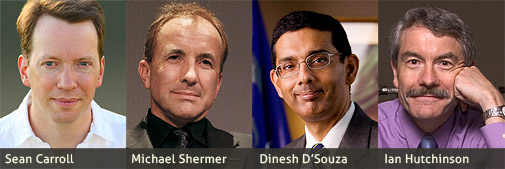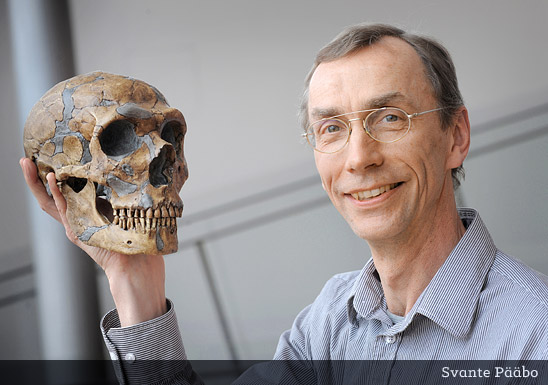In this week’s eSkeptic:
- Our Next Science Lecture: Neanderthal Man: In Search of Lost Genomes
- Skepticality: Taboo: The Questions You Aren’t Supposed to Ask
- Feature: Dead Silence: A “Live” Seminar With John Edward
- Rent a Science Lecture: The Great Debate: Has Science Refuted Religion?
- Dealing with Internet Misinformation: rbutr plugin updates
Our Next Science Lecture
Neanderthal Man: In Search of Lost Genomes
with Dr. Svante Pääbo
Sunday, March 2, 2014 at 2 pm
Baxter Lecture Hall
SVANTE PÄÄBO IS THE FOUNDER of the field of ancient DNA and is the director of the department of genetics at the Max Planck Institute for Evolutionary Anthropology in Leipzig. In Neanderthal Man he tells the story of his mission to answer the question of what we can learn from the genes of our closest evolutionary relative, culminating in his sequencing of the Neanderthal genome in 2009. We learn that Neanderthal genes offer a unique window into the lives of our hominin relatives and may hold the key to unlocking the mystery of why humans survived while Neanderthals went extinct. Drawing on genetic and fossil clues, Pääbo explores what is known about the origin of modern humans and their relationship to the Neanderthals and describes the fierce debate surrounding the nature of the two species’ interactions. A book signing will follow the lecture.
Order Neanderthal Man from Amazon.


Taboo
SKEPTICALITY EPISODE 226
In this episode of Skepticality, Derek sits down with Jeremy Steele, author of the new book Taboo: The Questions You Aren’t Supposed to Ask. Jeremy is not only an author and skeptic, he is also a practicing Methodist Pastor. Derek discusses what led a man of devout faith to be such a strident skeptic, and how his skeptical themed book came to be.

About this week’s eSkeptic
In this week’s eSkeptic, three skeptics join a crowd of about 2500 people at a seminar with renowned psychic, John Edward, and relay their experience in the following piece. This article appeared in Skeptic magazine issue 10.2 (2003).
Brady J. Phelps is Professor of Psychology at South Dakota State University; Scott C. Pedersen is Assistant Professor of Biology at South Dakota State University, Elizabeth C. Wogen is from Brookings, SD.
Share this article with friends online.
Subscribe | Donate | Watch Lectures | Shop
Dead Silence
Our Experience at a “Live” Seminar
with John Edward
by Brady J. Phelps, Elizabeth C. Wogen,
and Scott C. Pedersen
John Edward came to Omaha, NE, in November, 2002, and appeared before a crowd of approximately 2,500 people. Some had traveled from as far away as Kentucky to see “the man who speaks for the dead.” The scene had a revival meeting feeling, but instead of Bibles, Edward’s devotees clutched dogeared copies of his bestseller One Last Time. Three skeptics also joined the crowd and paid $45.00 to experience the Edward miracle. One skeptic— Brady Phelps—wore some buttons with photos of relatives who were still very much alive to see if Edward could be lured into trying to channel the living, but the opportunity never came.
Since there was no reserved seating there was chaos as the crowd poured in. Outside, the scene was equally chaotic as a group known as REASON —Rationalists, Empiricists and Skeptics of Nebraska—were protesting, handing out “consumer watchdog” flyers to educate the crowd about Edward’s tricks and tactics. Believers hurried past, maintaining a blank stare of blissful ignorance on their faces—a “Stepford Wife” kind of look.
Born again Christians were also in force, urging those present to not seek the spirit world because of its alleged satanic connections. During the hour before the show started, Edward’s security staff and stage crew mingled anonymously with the crowd, preventing anyone who carried a REASON flyer from entering. When one of the co-authors hid some REASON flyers in her purse she was detained at the door by a uniformed officer by order of Edward’s plain-clothes security until the flyers were surrendered. Edward’s men, outfitted with in-ear headphones and in-sleeve microphones wanted to maximize their control of the show to insure that it came off with no hitches. Other staffers were taking digital “mug shots” of the crowd, and during the show a technician taped from the back of the auditorium.
Clap you animals, clap
The seminar, we were told, was not being taped for television. It was advertised as an opportunity for question-and-answers from the audience and readings from beyond the grave. The star emerged to thunderous applause.
Before taking any questions, Edward told the audience that he wanted people to understand the true purpose of “his mission” which was, ironically, that people shouldn’t need mediums to talk to the dead…except as a last resort! Edward declared that he wouldn’t “tell people just what they want to hear, as so many phony psychics do, since that would be unethical.” (Like Hamlet’s lady, he “doth protest too much methinks.”)
One of the first questions that Edward took from the audience was “Are the dead always with us?” His answer was reassuringly vague: those who have “passed over” (one is not to call them dead) have a very different concept of “always,” and as a result they are not with us “always.” And a good thing too, he added with a touch of humor, for we may not want them to catch us in embarrassing moments.
This was poor man’s psychotherapy—psychobabble akin to Dr. Phil or Dr. Laura. Edward offered the possibility of resolving guilt and other issues by “contact” with a loved one, who though dead, can still accept your overtures of love and pleas for forgiveness. Edward blended conventional Christianity with new age beliefs, dispensing traditional love and forgiveness (from beyond instead of from God) without any annoying guilt or regret.
Those on the other side must speak perfect English because Edward always understands them, no matter what their native tongue. (Amusingly, Harry Houdini’s mother, who died without knowing a word of English, must have also learned it on the Other Side, for the mediums of Houdini’s day always passed her words on to him in English.) At one point, Edward explained that the body is just the vehicle and the soul is the driver; even if the vehicle is wrecked, the driver can go on. The souls of the dead however, are now on a very different frequency (the vehicle must have had a radio in it).
Gone fishin’
Edward appeared to rely largely, if not exclusively, on cold reading techniques—a fishing expedition. “I’m getting a Joe … Joseph … Jack … or a J-word and this is from a father … father-in-law … or a father figure to someone up there [in the balcony]. I am seeing this in connection with a maimed arm or possibly amputated arm from being caught in some type of machinery, possibly farm machinery. It could also be that the arm was run over by a tire.” When the individual he addressed could not make a connection, Edward repeatedly asked, “Who is near you? Who else is with you?” The audience, of course, wanted Edward to succeed, so they were willing participants in the deception. One individual, for example, volunteered that he had a grandfather who had a finger amputated. “No,” Edward replied, that was not what he was seeing. After three or four audience members could not make a connection, Edward jokingly threatened “Don’t make me come up there…” and he rationalized that maybe his thick “New Yawk” accent prevented the audience from understanding his references. Eventually Edward instructed the entire section to go home and think about it to see if the name of the father-figure came to them. It could also be some event that would happen in their future, he concluded. Well that pretty much covers everything, doesn’t it?
More than once Edward explained that he couldn’t see differences between a son, son-in-law, daughter or daughter-in-law and so forth—blood relations couldn’t be distinguished from legal ones as long as the relationship was loving. Then Edward went fishin’ again in the balcony: “I’m getting a name that sounds like Blackie … Block y… or Biloxi or maybe just a b-l-k sounding name….” No one responded. He again tried to get an association from several individuals sitting together in another section, but without success. More than one person was told “I am getting a message from your mother who has passed…” only to be told the that loved one was still in the land of the living.
For another audience member, Edward claimed that he saw her dead son or son-in-law, unnamed. She volunteered that it was a son who had died. Edward then made the cover-all statement, “I see that he died from some event or impact upon his body” to which the woman replied that her son had shot himself. “Oh, that must be the impact I saw,” he claimed. Rationalization, generalization, and after-the-fact reasoning are effective tools of the medium.
It’s a miracle!
Another time Edward targeted the audience directly in front of him: “I’m getting a flag image or a flag. Did anybody bring a flag with them? No sir, it’s not you,” referring to an audience member wearing an American flag sweatshirt. “Did you bring a flag with you?” pointing to a lady nearby. A flag was clearly visible on the front of her purse. (Flag wearing is up since September 11th.) Edward said he was “getting a Laurie, Linda or an L-word name.” Her name turned out to be Linda. Edward explained that for her he was getting “an older man, a father or father-like figure who died of liver damage or cirrhosis of the liver. I am seeing that this person who passed lived their life to the fullest and wouldn’t change a thing.” Linda suggested that it could be her uncle who had passed. “Linda, what’s the card trick or poker trick? Did your uncle know any card tricks or love to play cards?” “Yes!” she enthused. “Would he have been the type to possibly cheat at cards?” “Yes, he could have” she offered. “I’m getting that he was called an SOB or a bastard, but in a playful way, and he would say that back to you in return, but also in a playful way.” Linda again validated Edward’s assertions, but anybody who couldn’t see the logical relations between those generalities doesn’t know much about human behavior. Edward then pointedly asked “Linda, what is wrong with your left leg?” To which Linda again validated, “It’s my knee, it sometimes hurts me.” Given that Linda was middle-aged, a shot in the dark about a specific sounding complaint that is very common was not a wild guess.
I see dead people
Edward claimed he saw those who had passed so clearly that he sometimes confused them with the living. As a hospital employee, Edward said that he had developed an acquaintance with the son of a dying female patient. The two men often nodded at each other as Edward went about his duties in a simple daily exchange of hello or goodbye. When the woman “passed,” Edward waited patiently outside her room before entering to allow the son to pay his final respects. But a co-worker shocked him by telling him the room was empty and no such “son” had ever been to visit. (Since Edward had said he couldn’t distinguish blood relations from in-laws, maybe he also suffers the same confusion with materializations of those who have passed….)
According to Edward, those who have passed could also be captured on film in the form of amorphous “orbs” (which most readers should recognize as a buzzword among “ghostbusters”). So when you see those odd little blobs of colored light in your pictures, don’t crop them out; instead, enlarge them, frame them, put them alongside your other family photographs. It might be your uncle Fred.
To the believers present, Edward was clearly batting 1.000, and the experience of hearing him was priceless. It is difficult to keep score of his hits and misses since Edward asks many questions in rapid succession without waiting for an answer. But in this unedited performance his misses outnumbered his hits by about 20 to 1. The believers who were present saw and heard what they wanted; nothing was going to change their beliefs; but to the skeptics present, Edward came across as nothing more than a vulgar and fast-talking emotional parasite. ![]()
Sean Carroll, On Demand
The Great Debate:
Has Science Refuted Religion?

Caltech cosmologist and physicist Sean Carroll teams up with Skeptic magazine publisher and science historian Michael Shermer in this epic debate with noted conservative author and King’s College President Dinesh D’Souza and MIT physicist Ian Hutchinson as they go head-to-head over one of the most controversial issues of our age. As science pushes deeper into territory once the province of religion, with questions such as Why there is something rather than nothing?, Where did the universe come from?, How did life arise?, What was the origin of morality?, and others, inevitable conflicts arise over the best approach to answer them.
Rent this video for only $3.95
or explore the entire series.
INSTRUCTIONS: Click the button above, then click the RENT ONE button on the page that will open in your Internet browser. You will then be asked to login to your Vimeo account (or create a free account). Once you complete your purchase of the video rental, you will then be able to instantly stream the video to your computer, smartphone, or tablet, and watch it for the rental period.
The rbutr browser plugin brings accountability to the Internet.
As skeptics, we know we can’t trust everything we read on the internet. So, how do we deal with the endless amounts of misinformation we find?
The rbutr browser plugin provides a genuinely unique solution to this problem by providing a type of ‘peer review’ system for the internet. With browser plugins for Chrome and Firefox, users are alerted when the page they are currently viewing has been disputed somewhere else on the internet. This system reminds us to question the articles we’re are reading, and provides us with direct access to critical analyses of the information we read. Yet, rbutr remains completely neutral on all subjects.
New Way to Link to Misinformation
rbutr has just released a new tool which allows anyone, in any platform to access the rbutr concept by simply adding rbutr.com/ to the beginning of any URL. When this is done it will reload the page within a Frame which provides access to the rebutting pages, alerting the visitor that the information they are currently viewing has been disputed, and that they should therefore perhaps approach it skeptically.
More importantly, this tool also allows people to link to dubious content (misinformation, falsehoods, agenda driven articles etc) without providing any social media or SEO benefit, as always happens whenever you tweet, facebook or post a link to other internet forums. Further empowering the people who combat misinformation everyday.
Watch the Introductory Video to Get Started ⇧
To get started, click the YouTube banner above to watch the introductory videos. For more information, visit rbutr.com or check out the rbutr blog.














